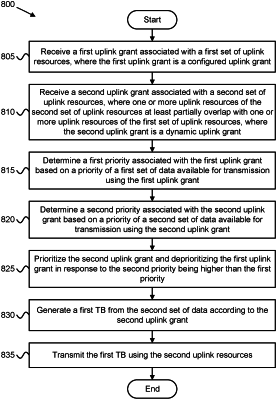| CPC H04W 72/23 (2023.01) [H04L 1/1812 (2013.01); H04L 5/0048 (2013.01); H04W 72/569 (2023.01)] | 20 Claims |

|
1. A user equipment (“UE”) for wireless communication, comprising:
at least one memory; and
at least one processor coupled with the at least one memory and configured to cause the UE to:
receive a first uplink grant associated with a first set of uplink resources, wherein the first uplink grant is a configured uplink grant;
receive a second uplink grant associated with a second set of uplink resources, wherein one or more uplink resources of the second set of uplink resources at least partially overlap with one or more uplink resources of the first set of uplink resources, wherein the second uplink grant is a dynamic uplink grant;
determine a first priority associated with the first uplink grant based on a first set of data available for transmission using the first uplink grant; determine a second priority associated with the second uplink grant based on a second set of data available for transmission using the second uplink grant,
prioritize the second uplink grant and deprioritizing the first uplink grant in response to the second priority being higher than the first priority;
generate a first transport block (“TB”) based on the second uplink grant; and
transmit the first TB using the second set of uplink resources.
|